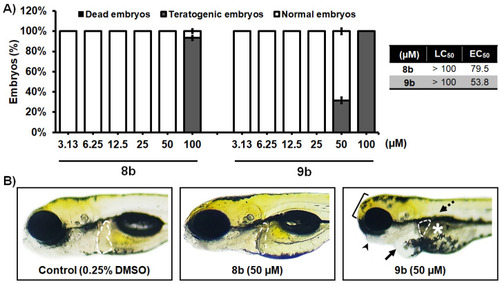Figure 8
- ID
- ZDB-FIG-221226-287
- Publication
- Ruzic et al., 2022 - Discovery of 1-Benzhydryl-Piperazine-Based HDAC Inhibitors with Anti-Breast Cancer Activity: Synthesis, Molecular Modeling, In Vitro and In Vivo Biological Evaluation
- Other Figures
- All Figure Page
- Back to All Figure Page
|
In vivo toxicity assessment of 1-benzhydryl-piperazine-based HDAC inhibitors 8b and 9b in the zebrafish (Danio rerio) model. (A) Acute toxicity was assessed using wild type (AB) embryos exposed to different doses of tested molecules, and expressed as the LC50 and EC50 doses. Embryos were treated at 6 h post fertilization (hpf), and evaluated for survival, teratogenicity, cardiotoxicity, and hepatotoxicity at 120 hpf (n = 60 per a dose). (B) Embryos exposed to 50 µM of 8b were normally developed embryos, without signs of cardiotoxicity, hepatotoxicity, and teratogenicity. On the other hand, treatment with 9b in some embryos provoked pericardial edema (arrow), weakly resorbed yolk (asterisk), malformed head (bracket) and jaw (arrowhead), no inflated swim bladder (dashed arrow), and decreased and dark liver (outlined). No adverse effect on the liver was detected at 50 µM of 8b, while reduced liver size and darkening (necrosis) occurred in embryos exposed to 50 µM of 9b. |

